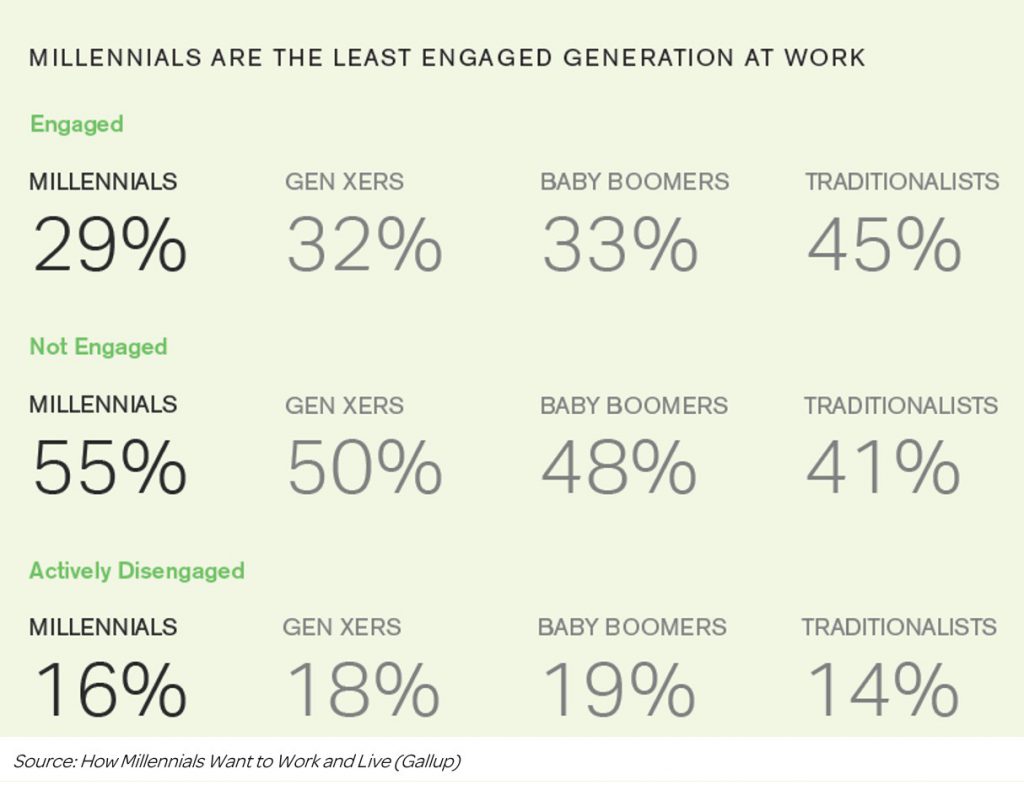Why engaging your employees is vital
on 3 December 2017 for CompaniesIncreased Profits, Higher Productivity, Lower Absence, Higher Retention

In the current business landscape, competition for both customers and employees is fiercer than ever before. Despite this, we see more and more in the media that employees aren’t happy in the workplace.
What’s the solution?
For many, the solution is simple and can be defined in two words – employee engagement.
It’s being discussed in boardrooms all over the world and managers are implementing strategies in attempts to re-engage their employees into the organization. Whether it is a reward program, or something simple like drinks after work, companies worldwide are spending a lot of time and effort on employee engagement.
But, are these the right things to do?
And however, there are still some managers that are unaware of the benefits of an engaged workforce.
What is employee engagement?
An engaged workforce consists of employees that are passionate about what they do. They love doing their work and are fully committed to the company goals.
For all companies, the holy grail is to have employees who are motivated and energized by their work and who have a strong fit with the organization.
Shocking Employee Engagement Statistics
Before we look into why you should be engaging your workforce and give you tips to do it correctly, let’s look into some shocking statistics.
Firstly, did you know that nearly 3,5 million employees in Belgium don’t feel engaged or committed to their work? This is about 77% of the total active population.
This puts Belgium at the bottom of the European ranking but the problem is bigger than that as just 29% of the global workforce are engaged at work.

The main reasons for this are: high workload, not a proper fit, no personal development, no defined role etc.
However, different age groups have different concerns and we can take it a step further and divide engagement into different generations. After breaking it down, you will see below that Millennials (18-34 years old) are the least engaged of all.
By the year 2020, Millennials will make up half of the global workforce which means that having 55% of them not engaged in their work is a huge problem!

How do we fix this problem?
First, we have to understand what their main concerns are and we do this via surveys and interviews at Exellys. By mentoring and coaching young professionals, we have learned that:
- Rigid corporate structures can cause discomfort.
- Feedback is vital and they expect a varied career.
- Flexibility is important.
- Learning opportunities and promotion has to be achievable.
- Their work has to be recognized and worthwhile.
Watch our video on expectations of young professionals
Currently, we know that many companies do not have the same culture, management style, or recruitment and retention policies that young professionals are looking for and we believe this is the source of the problem.
Why is Engagement Important?
As promised, let’s take a look at why engagement is so important.
Increased Profits – Nearly 50% more earnings and therefore an increase of 12% profit is obtained when employees are engaged. Also, employees are 18% more productive.
Higher Customer Satisfaction – Engaged employees will want customers to be happy which results in a 10% increase in customer satisfaction.
Innovation – Engaged employees will want to contribute more in terms of innovation.
Lower Absence Rating – Absence is a huge issue for companies but engaged employees have 50% less days of absence and less time off due to stress.
Staff Retention – When employees are engaged, they are nearly 90% less likely to leave and will even recommend your company to others.

The best way to really see how effective it can be, is to use an example.
Company X has an annual turnover of €30 mio and an average profit of €6 mio. Each employee (in total 50) of this company works about 200 days/year, and is on average 10 days absent. The general cost to replace an existing employee by a new one (employee turnover) is about €30,000.
When Company X starts engaging its workforce, it could add up €720,000 more profit each year. The work that would have been done in one year (200 days) before engaging the employees, could now be done in 160 days resulting in 40 extra days of work as result of a more productive workforce (in total: 50×40 = 2000 extra workdays!). Also, the number of absenteeism days will be on average 250 days (compared to 500 days before). Finally, the company will also annually save huge costs as a result of a higher retention rate.
Now you see why it is so important to start engaging your employees!
5 Tips to Start
With all this information, you want to get started. But how?
Unfortunately, you can’t just arrange an outing once a month and reap the rewards because it takes time and effort. Everybody in the organization has to work towards a single goal and these are some good tips to get started.
Focus on development
Since the start of Exellys, we decided to launch the Future Leaders Academy because we believe that training and coaching is vital for success in the future. Here, we train consultants various soft and technical skills. This academy consists of the Start Smart training program (from graduate to young professional) and the Grow Smart track (from young professional to young future-fit leader).
Furthermore, we based a lot of our attention on the personal development of our consultants so everyone has an opportunity to keep to a personal development plan that tracks their growth.
Give ‘inside’ information towards the bigger picture
At Exellys, we arrange quarterly meetings (‘Meeting of the Minds’) where we share ‘inside’ information. Employees learn from the managers and vice versa. Afterwards, everybody has a better understanding of what is going on.
This can be a great way to explain decisions, inspire colleagues and brainstorm for new ideas.
Emphasize work-life flexibility
In years gone by, working 9 to 5 has been the standard but Millennials don’t want this. Instead, they want more flexibility so consider adapting schedules and allowing certain tasks to be done at home. Give them access to (online) tools that allow them to organize their workload.
This way, employees will find a balance between work and personal life.
Encourage suggestions and transfer complaints
In our company, we introduced an ‘Advisory Board’ consisting of four consultants. They take all suggestions from their colleagues and act as spokespeople when relaying them anonymously to the management.
In addition to this, they have even started small projects to optimize our way of working. Most recently, they created a list of FAQs for new employees, introduced a buddy-system for newcomers and gave input to launch our internal newsletter.
Allow employees to plan events
At Exellys, we like to have fun with our employees and build a real team spirit. Our ‘Party Committee’, consisting of one manager and four consultants, plan various events and are elected yearly. The committee plans around six events each year from team-building and sports activities to meals out at a restaurant.
These five tips have allowed our business to move forward and we believe that they can help you to do the same. As soon as you start focusing on engaging your employees, you will see a return as they try their best on all tasks. Rather than simply sticking to their job description, they will be far more willing to go above and beyond because they feel valued and they know that rewards are in place.
Now, it’s over to you! Why not try even just one of the ideas listed above and watch the difference it makes? Not only will your employees feel motivated, you will also feel great for helping them to get there!
Sources:
- Effectory International, Global Employee Engagement Index 2016, Vol 3
- Gallup, How Millennials Want to Work and Live
- Global Employee Engagement Index: www.employee-engagement -index.com
- Sarah Sladek, author of ‘Knowing Y: Engage the Next Generation Now’
Tags: company culture , talent attraction , talent retention




